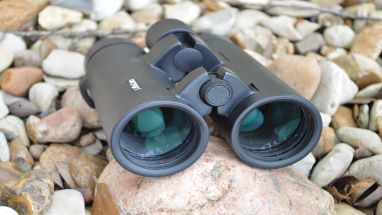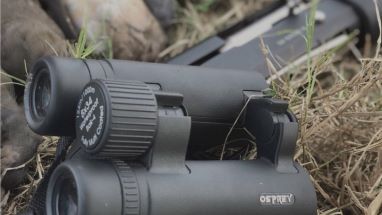Posted by Team Osprey on Jul 29th 2020
10x42 Binoculars, Review And Comparison
10x42 Binoculars, should I get a pair?
Osprey Global Is More Than Just Tactical and Hunting Gear.
Ar Optics and Tactical Riflescopes are not the only things that Osprey Global are famous for. Today we are going to take a closer look at the 10x42 Binoculars. It has been a staple of the Osprey brand for a few years now we think it warrants a quick look to see why. Osprey Global Optics does make other binoculars, and depending on what you are doing you may prefer the 8x34 Binoculars or the variable 10-22x50 Binoculars. Most bird watching websites recommend a 10x42 and it is the preferred dimension for the majority of hunters, finding that they are the perfect mix of a small enough size without compromising quality.
Popular Binoculars Compared
From the Osprey Global 8x34 Binoculars to the 10-22x50 Binoculars here is a quick run down of the other binoculars that Osprey Global Make and their ideal purposes.
The 10-22x50 -
These Binoculars have the highest magnification that Osprey make. So if you are looking for straight up distance and see as far as you can or seeing details like animal tags or reading signs then they are ideal. The trade off for the superior capable distance is firstly the speed at which you can find and focus your target. Since it is a variable zoom it can take multiple adjustments to get perfect clarity, ultimately taking some extra time. The second trade off of all 10-22x50 Bino's is that to get a large range of zoom it does sacrifice slight image quality at each end. They do everything well but they do lack some speed and some clarity when compared to the 10x42 Binoculars.
The Osprey 8x34 Binoculars and 10x26 Binoculars -
These two Binoculars are handy, compact and clear. Unlike the 10-22x50 Binoculars they retain speed of acquisition and the glass quality is superb at each end. They have the same essential design as the 10x42 Binoculars. They are both smaller than the 10x42 and even easier to fit in a pocket, making them ideal for day use. Many bird watching clubs recommend the 8x34 bino's for beginners as they have a slightly larger field of view making it easier to find the bird. The trade off for their super lightweight and size is their low light capabilities. Considering the smaller objectives they have mean that less light is able to get into the binocular, creating an image that has slightly less clarity than the 10x42 Binoculars.
Binocular Magnification Numbers And What They Mean
Understanding Binocular range numbers and binocular objective numbers is important to choosing the optimal binoculars for your purpose. It can be a bit intimidating like a high school algebra class, but once you understand the concept you can choose the right Binoculars for your purpose confidently. The Binocular power numbers are the first one or two numbers. The last number is always the objective size. If it has 3 numbers then it is a variable zoom if it has only 2 numbers then it is a fixed power. To give you some examples the 10-22x50 is a ten power that can be zoomed to 22 power or magnification and it has an objective of 50mm. The 10x42 Osprey Binoculars are a fixed ten power Binocular with an objective of 42mm. Now we got the basics of numbers. The next important thing to understand is the importance of the Binoculars objective.
Binocular Objective And Why It's Important…...Sometimes
Binocular objective diameter is an important factor to consider, but so is the glass, size, magnification, prism, coatings and design. The objective is the size of the front lens measured in diameters. So a 34mm lens won’t get in as much light as a 42mm lens. Think of it as a window letting sunshine in your room, the bigger the window the brighter the room. The more light that is transferred the more clarity your picture will have. This is not the be all and end all, it is not a hard and fast rule where the bigger the front lens diameter the better the picture quality. If you have an inferior design or prism system or large variable range then all of this can affect image quality. Glass quality is also paramount, and not a subject to ignore.
Hoya Optical Glass And Why It Matters
We all know glass is important but many don't know why one glass is sharper than another. In a nutshell you are looking for 2 main things. You want Fully Multi coated Lenses and you want a low dispersion glass ( ED). The Osprey Optics come with both of these on their lenses. We use Hoya glass exclusively on our binoculars.The multi coated layer basically means that much less light is reflected back out of the binocular, allowing it to maximize the use of the available light. This means you need less light to see clearly. On inferior binoculars you can see a lot of reflection and that means a lot of lost light.
The second factor is having low dispersion glass. Low dispersion glass controls light and aberrations.It basically controls the light inside the tube. Any light that is not controlled bounces around inside the tube and can contribute to blur.I don’t want to get into the weeds on glass quality but the short story is that Osprey Global use Hoya glass which is the same glass used in professional camera lenses, riflescopes and high end binoculars.
Binocular Lens Coatings And Prisms
The Osprey 10x42 binoculars have the BAK-4 Prisms. Without getting too technical, this is the industry leading prism for encouraging light transition. The Osprey optics have done a lot to get excellent light transition, they have also added phase correction coatings so the glass retains not only good light but also the correct, un-tinted colors. Many binoculars in this price range give unrealistic colors, sometimes slightly tinted yellow or green which takes away from the viewing experience.
The last thing that has been done with the prism to control the light is to make it a roof prism. This means that the light enters at the front objective and travels in a direct line to deliver the light/picture. In more traditional binoculars the light enters the objective but has to literally turn a corner to reach the dioptic. This is why the Osprey10x42 binoculars have a clearer image than most binoculars with a larger objective.
The Osprey Global 10x42, Distance and Field of View
Field of view is very good at 106m/347 feet at a hundred yards. This makes them ideal for low to mid range use like hunting, bird watching, outdoor sporting events and vacations. It can also focus very close ( 4.9 feet to be exact) and with the smooth center focus wheel it is one of the easiest binoculars to adjust in a hurry.
Osprey Global 10x42 Binoculars And What To Expect Out The Box
What are you getting for your money? The glass is impeccable. The design is excellent for this price range. The field of view isn’t crazy but I prefer a close focus system than a larger field of view but that's a personal preference. You get a strap, lens covers, a bag and a no questions asked lifetime warranty.
Real World Performance
The 10x42 Binocular feels sturdy. It is rubber coated and it feels tough without being heavy. We have personally seen them dropped, kicked, fall in a pond AND a stream ( two separate occasions) and they have never given us any issue which speaks volumes for their ruggedness. In fact they are completely waterproof and fog proof. They are ‘O’ ring sealed to ensure they remain waterproof and stop any leakage which also helps ensure against fogging. In fact the cylinders are filled with argon gas and not nitrogen making it less likely to fog as Argon is less water dense. The view range has an 18mm eye relief making it very forgiving to look through. They have twist-able eye-cups making it comfortable to use with or without your glasses. They feel and perform like a much more expensive set of binoculars than they are.
Osprey Global Binoculars 10x42, should I get a pair?
The short answer is yes. They are comfortable and tough and perform like a much more expensive piece of glass. If you need 350 feet of field of view at 1000 yards then these are not ideal, but if you are looking for an impressive all-rounder that is rugged AND precise you will be more than impressed. Sitting around the $200 price point they are affordable and the life time warranty is an industry leader. There is no other product made by Osprey Global that I think everyone should own. I own multiple pairs, one set in my truck, one in the house and many people in my family and friend group have a set. In fact this year I gave a pair to my mother for mother's day; so either I really believe in them as a product or I am a terrible son. If that isn't proof we don’t know what is.
Other Osprey Global Binocular Options.
We get asked all the time “what are the best binoculars for general use”. As always the answer is “ it depends” If you are looking at well lit sporting events or hiking then the Osprey Global 10x26 Binoculars or Osprey Global 8x34 Binoculars are excellent options for day time and bright scenarios. They are smaller and easier to carry. The Osprey Global 10x26 Binocular is actually our bestselling binocular glasses for sporting events. The Osprey Global 10-22x50 Binocular is the best for details and distance on the go. For the ultimate in distance the Osprey Global Spotting Scope 20-60x80 is unreal and you can see a squashed fly at 800 yards. People ask “ what's the best binoculars for Bird watching” or “ the best binoculars for hunting”. I tend to lean heavily on theOsprey Global 10x42 Binocular for all my needs and they haven't let me down. In saying that, consider your goal and buy appropriately. You won’t be let down no matter what option you choose, these are the best binoculars under $300 on the market.


